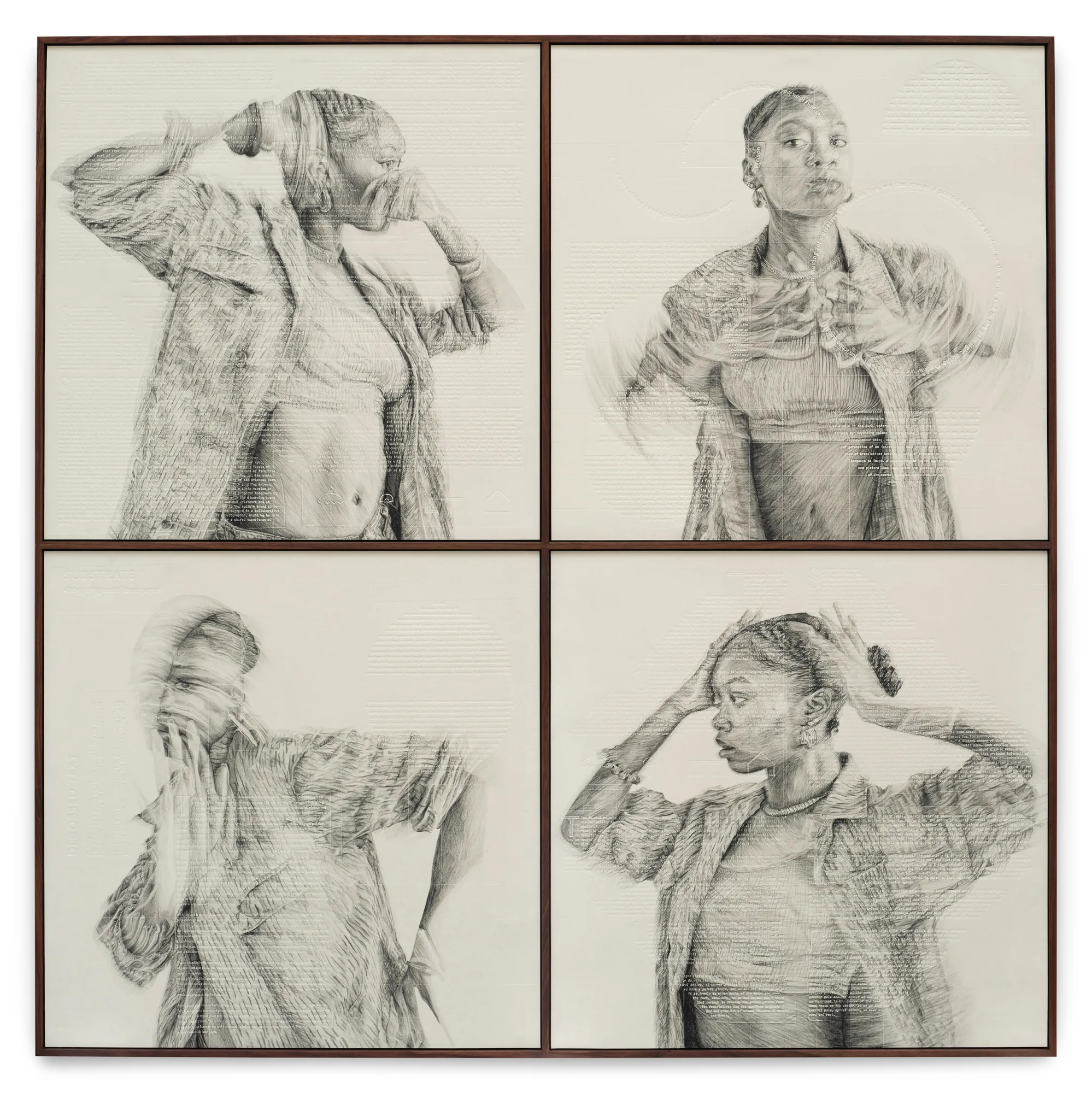Overview
Stephen Friedman Gallery is pleased to present clouds, Kenturah Davis’ debut solo exhibition in the UK.
Stephen Friedman Gallery is pleased to present clouds, Kenturah Davis’ debut solo exhibition in the UK.
Studio Film

Kenturah Davis is a multi-disciplinary artist based in Los Angeles, California. Her work hinges on a belief of language as fundamental to every persons understanding of themself, and the world around them. Questioning how, as humans, we use and misuse language, Davis begins by overlaying her drawings with written word, contextualizing the kinetic figures of Black women in each frame. The writings embossed onto Japanese kozo paper are a mixture of the artists’ own meditations and some she has borrowed from pioneering creatives of the past, like choreographer Katherine Dunham—known for fusing dance with the field of anthropology to put forth radical notions of space, time, and Black diaspora.
"There is never one singular way of visualising, seeing, or engaging with someone."
Kenturah Davis

"We acknowledge that we see a sort of exterior and that it has this kind of interior that holds other things, and that is parallel to how I think of the figure or even a person. We as people walking around are to some degree a kind of vessel. We are carriers of information.”
Kenturah Davis


If one were to enter Kenturah Davis’ studio, they might hear a familiar tune, catch a whiff of incense, and spot a stunning dancer in unrehearsed motion. Each piece in the artist’s new solo exhibition, ‘clouds’, is a study of movement. Though Davis would like her subjects to be guided most by what is natural to them, on occasion the artist sways her participants with different prompts. For instance, she often finds herself drawn to a particular gesture which she then asks her subjects to repeat on a loop.
‘volume II (marjani)’ is a single drawing accompanied by a vessel made from walnut. The hand carved structure fits snugly into a rectangular pocket of the frame, separated only by a thin wall of wood. Marjani, the dancer, points out at the spectator. Smudges of charcoal rubbing reproduce the hazy effects of her fingers in fluid motion. The recessed mantle of the frame bears deep brown sinuous curves that distinguish it from the paler wood marbling of the cylindrical vessel. The viewer has much to contemplate: the figure, the paper imbued with text, and the carved wooden counterpart.

“My own work coalesces around experiments with the physicality of language. By writing or stamping texts in repetition, figures materialize as an embodiment of the texts used to render them.”
Kenturah Davis

The Cloud Drawings




Artist Biography
Kenturah Davis was born in 1980 in Los Angeles, California. She earned her BA from Occidental College in Los Angeles and an MFA from Yale University School of Art in New Haven, Connecticut. She has had several notable solo exhibitions in recent years including ‘Dark Illumination’, Oxy Arts, Los Angeles, California (2023); ‘Apropos of Air’, Matthew Brown Gallery, Los Angeles, California (2021); ‘(A)Float, (A)Fall, (A)Dance, (A)Death’, Jeffery Deitch Gallery, New York, New York (2021); ‘Everything that Cannot Be Known’, SCAD Museum of Art, Savannah, Georgia (2020); and ‘Blur in the Interest of Precision’, Matthew Brown Gallery, Los Angeles, California (2019).
Her work is represented in numerous collections including the Blanton Museum of Art, Austin, Texas; Brooklyn Museum, New York, New York; Guggenheim Museum, New York, New York; Hammer Museum, Los Angeles, California; Institute of Contemporary Art, Boston, Massachusetts; Los Angeles County Museum of Art, Los Angeles, California; Metropolitan Museum of Art, New York, New York; Museum of Contemporary Art, Los Angeles, California; Museum of Fine Arts, Houston, Texas; Museum of Modern Art, New York, New York; Perez Art Museum, Miami, Florida; Rubell Family Collection; National Portrait Gallery, Smithsonian, Washington D.C.; Studio Museum, New York, New York; Walker Art Center, Minneapolis, Minnesota; and Yale University, New Haven, Connecticut.




















